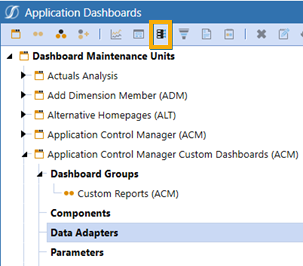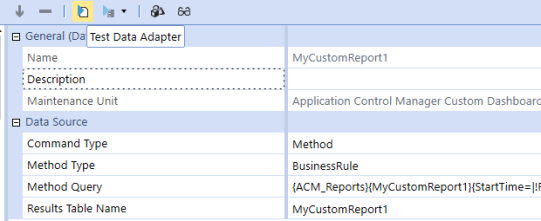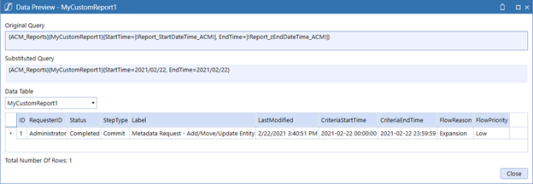You can add custom reports using combinations of business rules, dashboard data adapters, dashboard components, and dashboards.
NOTE:
Follow the sample steps below to add a new custom report to show the values of the custom properties FlowReason and FlowPriority.
-
Add the report definition to the ACM_Reports by navigating to Business Rules > Dashboard Data Set > ACM_Reports.
-
Add the report to the list of reports. Be sure to add the comma to the previous line.

-
Copy and paste rows 112-121 and update for the new report name.

- Insert the following code after line 331:
private DataTable GetMyCustomReport1(SessionInfo si, string startTime, string endTime)
{
try
{
using (DbConnInfo dbConnFW = BRApi.Database.CreateFrameworkDbConnInfo(si))
{
using (DbConnInfo dbConnApp = BRApi.Database.CreateApplicationDbConnInfo(si))
{
endTime = endTime.Replace("/", "-") + " 23:59:59";
// Create the data table to return
var sql = new System.Text.StringBuilder();
sql.Append("Select r.ID, r.RequesterID, r.Status, ");
sql.Append("'Commit' As StepType, f.Label, r.LastModified, ");
sql.Append("'" + startTime + "' As CriteriaStartTime, ");
sql.Append("'" + endTime + "' As CriteriaEndTime, ");
//For item level properties, use i.ItemProperties instead of r.RequestProperties
sql.Append("JSON_Value(r.RequestProperties, '$.Properties.FlowReason') As FlowReason, ");
sql.Append("JSON_Value(r.RequestProperties, '$.Properties.FlowPriority') As FlowPriority ");
//FOR ITEM LEVEL PROPERTIES, UNCOMMENT NEXT 2 LINES
// sql.Append("From " + ACM_Globals.m_ItemView + " i ");
// sql.Append("RIGHT Join " + ACM_Globals.m_MasterRequestView + " r On i.FKRequestID = r.RequestID ");
sql.Append("From " + ACM_Globals.m_MasterRequestView + " r ");
sql.Append("INNER JOIN " + ACM_Globals.m_StepTable + " s ON r.FKStepID = s.StepID ");
sql.Append("INNER JOIN " + ACM_Globals.m_FlowTable + " f ON r.FKFlowID = f.FlowID ");
sql.Append("WHERE s.StepType = 3 AND r.Status = 'Completed' AND ");
sql.Append("r.LastModified >= '" + startTime + "' And r.LastModified <= '" + endTime + "' ");
sql.Append("ORDER BY r.LastModified DESC");
using (var dt = BRApi.Database.ExecuteSql(dbConnApp, sql.ToString(), false))
{
dt.TableName = "MyCustomReport1";
return dt;
}
}
}
}
catch (Exception ex)
{
Logger.Write(si, "Error getting Activity Log Report.", ACM_Globals.LogLevel.ERR, ACM_Globals.LogCategory.AcmReports, ex);
throw ErrorHandler.LogWrite(si, new XFException(si, ex));
}
}This is what it will look like in the business rule:
private DataTable GetMyCustomReport1(SessionInfo si, string startTime, string endTime)
{
try
{
using (DbConnInfo dbConnFW = BRApi.Database.CreateFrameworkDbConnInfo(si))
{
using (DbConnInfo dbConnApp = BRApi.Database.CreateApplicationDbConnInfo(si))
{
endTime = endTime.Replace("/", "-") + " 23:59:59";
// Create the data table to return
var sql = new System.Text.StringBuilder();
sql.Append("SELECT r.ID, r.RequesterID, r.Status, ");
sql.Append("'Commit' AS StepType, f.Label, r.LastModified, ");
sql.Append("'" + startTime + "' AS CriteriaStartTime, ");
sql.Append("'" + endTime + "' AS CriteriaEndTime, ");
// For ITEM LEVEL Properties, use i.ItemProperties instead of r.RequestProperties
sql.Append("JSON_Value(r.RequestProperties, '$.Properties.FlowReason') AS FlowReason, ");
sql.Append("JSON_Value(r.RequestProperties, '$.Properties.FlowPriority') AS FlowPriority ");
// For ITEM LEVEL Properties, UNCOMMENT NEXT 2 LINES
// sql.Append("FROM " + ACM_Globals.m_ItemView + " i ");
// sql.Append("RIGHT JOIN " + ACM_Globals.m_MasterRequestView + " r ON i.FKRequestID = r.RequestID");
sql.Append("FROM " + ACM_Globals.m_MasterRequestView + " r ");
sql.Append("INNER JOIN " + ACM_Globals.m_StepTable + " s ON r.FKStepID = s.StepID ");
sql.Append("INNER JOIN " + ACM_Globals.m_FlowTable + " f ON r.FKFlowID = f.FlowID ");
sql.Append("WHERE s.StepType = 3 AND r.Status = 'Completed' AND ");
sql.Append("r.LastModified >= '" + startTime + "' AND r.LastModified <= '" + endTime + "' ");
sql.Append("ORDER BY r.LastModified DESC");
using (var dt = BRApi.Database.ExecuteSql(dbConnApp, sql.ToString(), false))
{
dt.TableName = "MyCustomReport1";
return dt;
}
}
}
}
catch (Exception ex)
{
throw ErrorHandler.LogWrite(si, new XFException(si, ex));
}
}5. Compile the business rule to check the syntax.
Add Reports to the Application Control Manager Custom Dashboard
Add the reports to the Application Control Manager Custom dashboard as follows:
-
Click Application Dashboards > Dashboard Maintenance Units > Data Adapters.
-
Click Create Data Adapter.

-
Enter a name for the data adapter.
-
For Command Type select Method.
-
For Method Type select Business Rule.
-
For Method Query, click the ellipsis and add the following:
{ACM_Reports}{MyCustomReport1}{StartTime=|!Report_StartDateTime_ACM!|, EndTime=|!Report_zEndDateTime_ACM!|}
-
In Results Table Name enter MyCustomReport1.

-
Click Test Data Adapter to test the adapter.

You should see similar results to this:
